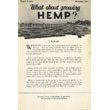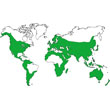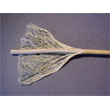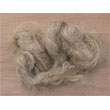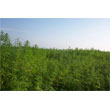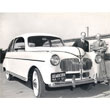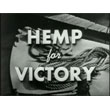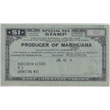...that the Declaration of independence and the first American flag made by Betsy Ross were made from a plant called Cannabis Sativa?
No, not that one! Although many confuse hemp with Marijuana (AKA, Mary Jane, dope, reefer, grass, ganja, pot, weed, mota and, well, you get the idea) it is NOT the same thing. Not only do the plants look completely different, but the hemp that is grown for industrial purposes if ingested, does not contain the levels of the chemical THC (Tetrahydrocannabinol) required to produce the same physical effects as its cousin (the one sometimes used for *ahem* "medicinal" reasons). Although the US is the leading importer of hemp and hemp products, especially now, this much-maligned member of the nettle family is not still permitted to be cultivated in the United States due to Federal regulations that have been in place since the 1950's. This wasn't always so. In fact for many years the government encouraged the propagation of this extraordinarily versatile, soil friendly crop. We hope that will change now that its cousin is being legalized in so many states, because it's an extremely useful plant. We should not have to import it half way around the world!
Did you know? - Hemp Seed is more nutritious than even soybeans, contains more essential fatty acids than any other source, is second only to soybeans in complete protein (but is more digestible by humans), is high in B-vitamins, and is 35% dietary fiber. Hemp seed used to be a very important nutritional component of the birdseed we bought for our pet birds. Hemp seed does not contain THC. Like bamboo, hemp grows well without herbicides, fungicides, or pesticides. A planted hemp seed will reach full maturity in less than half a year and grows well in a wide variety of climates. The bark of the hemp stalk contains bast fibers, which are among the Earth's longest natural soft fibers (the plants can grow 25 feet tall!) and are also rich in cellulose; the cellulose and hemicellulose in its inner woody core are called hurds. Hemp fiber is longer, stronger, more absorbent and more insulative than cotton fiber. Like true bamboo fiber, it also has antibacterial properties.
Hemp has been part of human culture for a very long time. Ancient humans derived everything from food to building materials from hemp and it has been cultivated on every continent on planet earth (with the possible exception of polar regions). Hemp is among the oldest industries on the planet, going back more than 10,000 years. The Columbia History of the World states that the oldest relic of human industry is a bit of hemp fabric dating back to approximately 8,000 BC.
In colonial times hemp was considered to be such a valuable resource that Americans were actually mandated to grow it and in some colonies it was used as currency. It was used for ropes, sails, clothing and many other things. It's also a fact that both the father of our country George Washington and President Jefferson both grew hemp. Our founding fathers considered the fiber so crucial to the American economy that it played a fundamental role in the War of 1812 as America and Britain fought for control of established hemp trade routes to Russia. It is also considered the impetus for Napoleon's failed invasion of Russia! Did you know that?!
Did you know? - In 1916, THE USDA reported that one acre of cannabis hemp, in annual rotation over a 20-year period, would produce as much pulp for paper as 4.1 acres of trees being cut down over the same 20 year period. This process would use only 1/4 to 1/7 as much polluting sulfur-based acid chemicals to break down the glue-like lignin that binds the fibers of the pulp, or none at all using soda ash. The problem of dioxin contamination of rivers is avoided in the hemp paper making process, which does not need to use chlorine bleach (as the wood pulp paper making process requires) but instead safely substitutes hydrogen peroxide in the bleaching process...If the new (1916) hemp pulp paper process were legal today, it would soon replace about 70% of all wood pulp paper, including computer printout paper, corrugated boxes and paper bags.
Did you know? - Hemp is the number one biomass producer on planet earth? 10 tons per acre in approximately four months. It is a woody plant containing 77% cellulose. Wood produces 60% cellulose. In the mid-19th century it was discovered that a fuel could be made from plant biomass that could power and automobile engine? Biomass can be converted to methane, methanol, or gasoline at a fraction of the current cost of oil, coal, or nuclear energy.
Fast forward to somewhere around 1930. Henry Ford's motor company began researching hemp for large-scale industrial use in the automotive industry. Everything from bio fuel to a super strong cellulose based "plastic" was explored. In 1941 Ford actually did unveil a car that was made from and fueled almost entirely by hemp!
During World War II the federal government provided subsidies for farmers to grow hemp to support the war effort. It's estimated that American farmers grew about 42,000 tons hemp of during the war. The USDA even made a promotional movie "Hemp for Victory" to encourage tobacco farmers to switch to hemp.
Needless to say Hemp is a fascinating plant with a colorful history. It has played a huge role in the growth of our civilization and is sure to play an increasingly important role in our future. It is estimated that around 25,000 different products are made from hemp including diapers, carpet, insulation and hair conditioner. We at Dharma like our hemp simply because it is a wonderful fabric. Strength, versatility and dye-ability, not to mention its odor controlling properties, make it very desirable. Clothing made out of hemp lasts for years and years (and doesn't smell - in theory). Why it is still illegal to grow here in our so called enlightened, scientific times, with our push for alternative energy and "green" sustainable crops, driving up the price for everybody, we do NOT know.
The good thing is that a lot more hemp products are for sale in the U.S. than used to be. Including a lot of super soft t-shirts made of "viscose hemp". That is another word for "rayon made out of hemp". It is not the same as cloth or knits made from the actual hemp fibers. It has none of the strength or odor controlling properties that make hemp so desirable. It is no different than any other rayon, including being a very weak fabric when wet. We have looked for years for a t-shirt made out of real hemp fibers for our customers. A lot of manufacturers of clothing have gone with hemp rayon because real hemp fibers are rough, let's face it. But now we know that blending it with cotton, and enzyme washing it, gets it soft enough, and it retains its "hempness". With every washing, it gets softer. But it never loses its strength or antimicrobial properties. With that, we introduce, tah dah, our own REAL Dharma Hemp T-shirt! We also have a number of hemp fabrics and hemp blends for your sewing pleasure here. Enjoy!









